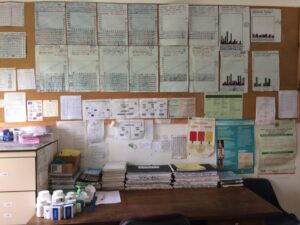How to Integrate Health Programs Into Health Systems
Download the Anatomy of a Health System
Welcome to Realizing Global Health. My name is Dr. Elvira Beracochea and I am the president, CEO and founder of Realizing Global Health. We are a global health consulting company where we help clients develop self-reliant sustainable health systems that deliver health care to everyone, everywhere, every day. We do that because we understand how health systems work and that is what we are going to talk about now. How do health systems work? How do we make sure that we are delivering health care to everyone everywhere every day? The answer is very simple—health programs.
We deliver health care because we have developed health programs that are running vertically across the health system. Last week, we talked about the structure of the health system and how the health system has three levels: governance, leadership and delivery levels. This is the basis of the pyramid of health services. How that works is because we have health programs. Health programs vary from country to country because sometimes different countries have different priorities. Usually, we have programs for child health, maternal health, TB, immunization, family-planning, HIV/AIDS, etc. Those programs are designed to meet the needs of the community.
These health programs need to meet three criteria:
- They need to be effective.
- They need to make sure that the health services that are going to be delivered meet standards – that is scientifically accepted, internationally demonstrated, quality standards.
- They ensure the respect of the patient’s – the patient’s privacy, his/her beliefs and the right to health.
These health programs, which are developed usually by the governance level in collaboration with different representatives and members of the other levels of the health system, are going to determine who gets what and how and where and when or not—this is what a health program is about. It is a guide that says how you have to deliver health services in this country to meet the needs of the population in that country. If the health program is not well designed, it’s out of date or not really meeting the needs of the population, then that needs to be improved. That is where we all can help improve health programs. There is always new information coming up and new things we can do to make the program more effective and improve quality standards and ensure respect in all of the citizens of a country.
It is important that we think: How will this health program be translated into health services? This is where the health provider comes in (doctors, nurses, physician’s assistant, health workers, etc.). The important thing is that the health provider is going to interpret the health program and then translate it into services—a package of services that is going to meet the needs of that particular location and the community it serves. It is important that the health provider knows how to translate what the health program says must be done into a package of services that meet the quality standards and will respect the patient.
Next time, we will be talking more about health providers and how services are delivered. Today, I want you to remember that we have a health system and health programs that make the health system run. Most importantly, we have human beings (health providers) that make it work on all levels and our job is to make sure that we help them. We help the health programs to be run better and the health providers to work better – that is the main purpose of global health.
I hope you can join us next time when we continue talking about the foundations of global health and what makes an effective global health program. Until then, please follow us on LinkedIn, Facebook and Twitter where we will share more information about what makes a difference in realizing global health.


